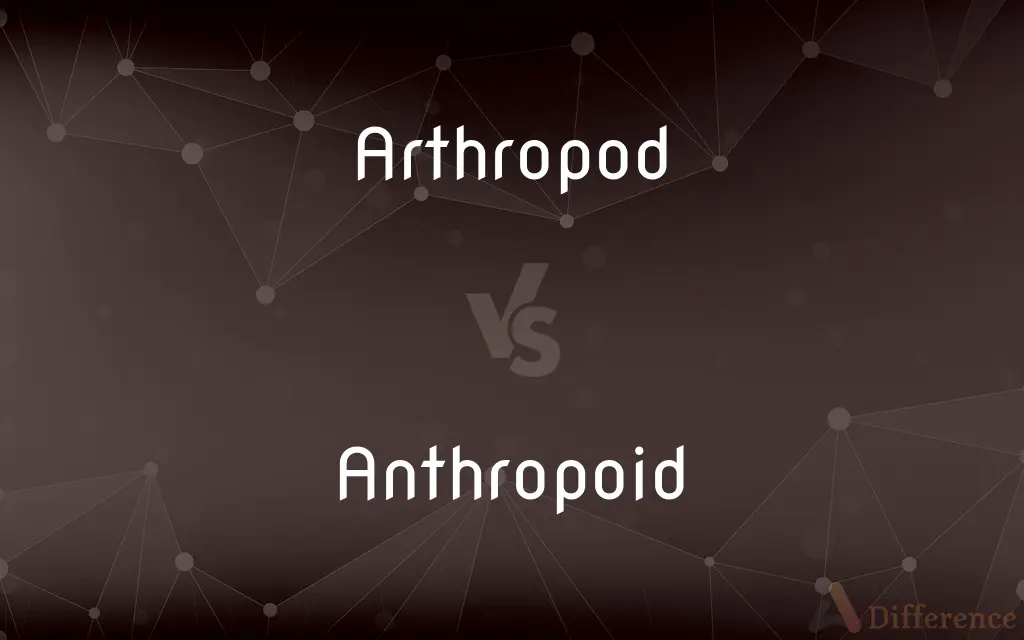Arthropod vs. Anthropoid — What's the Difference?
By Tayyaba Rehman & Urooj Arif — Updated on March 29, 2024
Arthropods are invertebrates with exoskeletons and jointed limbs, while anthropoids include humans and apes, characterized by their primate features.

Difference Between Arthropod and Anthropoid
Table of Contents
ADVERTISEMENT
Key Differences
Arthropods represent a vast phylum of invertebrate animals, including insects, arachnids, myriapods, and crustaceans. They are characterized by their exoskeletons, segmented bodies, and jointed limbs. Anthropoids, on the other hand, are a suborder of primates that include humans, apes, and monkeys, known for their higher brain functions, forward-facing eyes, and flexible limbs.
While arthropods are found in nearly every habitat on Earth, from the deepest oceans to the highest mountains, and have been present for over 500 million years, anthropoids are mainly terrestrial and are a relatively recent evolutionary group. Anthropoids are notable for their complex social structures and behaviors, traits that are less pronounced or absent in arthropods.
Arthropods exhibit a wide range of body sizes, from microscopic to several feet long, and possess an external skeleton made of chitin, which they must periodically shed and regrow in a process known as molting. In contrast, anthropoids have internal skeletons and their growth is not limited by an exoskeleton, allowing for continuous growth and development over their lifespan.
The sensory and nervous systems of arthropods are highly adapted to their environments, with some species having compound eyes and others having highly developed senses of smell or touch. Anthropoids, however, have more advanced brains and sensory systems, enabling complex thought, communication, and tool use, which are not observed in arthropods.
Comparison Chart
Definition
Invertebrates with exoskeletons, segmented bodies, and jointed limbs.
Suborder of primates including humans, apes, and monkeys.
ADVERTISEMENT
Examples
Insects, arachnids, crustaceans.
Humans, chimpanzees, gorillas.
Habitat
Nearly all environments on Earth.
Mainly terrestrial, in a variety of ecosystems.
Evolutionary Age
Over 500 million years.
Relatively recent in evolutionary history.
Body Structure
Exoskeleton made of chitin, segmented bodies.
Internal skeletons, flexible limbs.
Sensory Systems
Varies widely; compound eyes, antennae for smell and touch.
Advanced brains, forward-facing eyes, complex sensory systems.
Social Structures
Less pronounced or absent.
Complex social behaviors, communication.
Compare with Definitions
Arthropod
Diverse habitats.
Arthropods can be found in environments ranging from deserts to deep-sea vents.
Anthropoid
Primates.
Humans, considered anthropoids, exhibit complex social behaviors and tool use.
Arthropod
Exoskeleton.
Crabs must molt their exoskeleton to grow, a common feature among arthropods.
Anthropoid
Social structures.
Monkeys form intricate social hierarchies, demonstrating the complex social dynamics of anthropoids.
Arthropod
Jointed limbs.
Spiders use their jointed limbs to weave intricate webs.
Anthropoid
Forward-facing eyes.
The forward-facing eyes of chimpanzees provide them with depth perception, a trait common in anthropoids.
Arthropod
Segmented bodies.
Centipedes, which are arthropods, have bodies divided into many segments.
Anthropoid
Internal skeleton.
Gorillas, like all anthropoids, have an internal skeleton that supports their body structure.
Arthropod
Arthropods (, from Ancient Greek ἄρθρον (arthron) 'joint', and πούς (pous) 'foot' (gen. ποδός)) are invertebrate animals having an exoskeleton, a segmented body, and paired jointed appendages.
Anthropoid
Complex brains.
Anthropoids, including humans, have large brains relative to their body size, enabling advanced thought.
Arthropod
An invertebrate animal of the large phylum Arthropoda, such as an insect, spider, or crustacean.
Anthropoid
Resembling a human being in form
Anthropoid gods
Arthropod
Any of numerous invertebrate animals of the phylum Arthropoda, including the insects, crustaceans, arachnids, and myriapods, that are characterized by a chitinous exoskeleton, a segmented body, and jointed appendages.
Anthropoid
A higher primate, especially an ape or apeman.
Arthropod
An invertebrate animal of the phylum Arthropoda, characterized by a chitinous exoskeleton and multiple jointed appendages.
Anthropoid
Of or belonging to the primate suborder Anthropoidea, which consists of the New World monkeys, Old World monkeys, and apes including humans.
Arthropod
One of the Arthropoda.
Anthropoid
Resembling a human, especially in shape or outward appearance
A museum exhibit with several anthropoid ceramic coffins.
Arthropod
Invertebrate having jointed limbs and a segmented body with an exoskeleton made of chitin
Anthropoid
Resembling or characteristic of a nonhuman ape; apelike
An anthropoid forehead.
Anthropoid
A primate of the suborder Anthropoidea.
Anthropoid
Having characteristics of a human, usually in terms of shape or appearance
Anthropoid
Of the pelvis, having an anteroposterior diameter equal or exceeding the transverse diameter.
Anthropoid
Having characteristics of an ape
Anthropoid
An anthropoid animal.
Anthropoid
Resembling man; - applied especially to certain apes, as the ourang or gorilla.
Anthropoid
Person who resembles a non-human primate
Anthropoid
Any member of the suborder Anthropoidea including monkeys and apes and hominids
Anthropoid
Resembling apes
Anthropoid
Resembling human beings
Common Curiosities
How do arthropods and anthropoids reproduce differently?
Arthropods lay eggs, with some undergoing metamorphosis, while anthropoids give birth to live young and invest heavily in parental care.
Are there any similarities between arthropods and anthropoids?
Both groups are characterized by their ability to adapt to their environments, although the ways in which they do so and their physical structures are quite different.
What distinguishes an arthropod from an anthropoid?
Arthropods are invertebrates with exoskeletons and jointed limbs, while anthropoids are primates, including humans and apes, with advanced brains and social behaviors.
How do the sensory systems of arthropods compare to those of anthropoids?
Arthropods may have specialized sensory organs like compound eyes or antennae, while anthropoids have more advanced sensory systems, including complex vision and hearing, supporting higher-level cognitive functions.
How does the exoskeleton of an arthropod differ from the skeleton of an anthropoid?
An arthropod's exoskeleton is external and made of chitin, providing protection and structural support, whereas anthropoids have internal skeletons that support body structure and movement.
Can arthropods be found in the same habitats as anthropoids?
While both can occupy terrestrial environments, arthropods have a much broader range of habitats, including aquatic and extreme environments.
Do arthropods have brains like anthropoids?
Arthropods have nervous systems adapted to their needs, but they do not have brains as complex as those found in anthropoids, which are capable of advanced thought and communication.
Why are anthropoids considered more evolutionarily advanced than arthropods?
"Evolutionarily advanced" is a subjective term; however, anthropoids have more complex brains and social structures, which can be seen as more advanced in the context of cognitive and social capabilities.
What role do arthropods and anthropoids play in their ecosystems?
Arthropods play various roles, including pollinators and decomposers, while anthropoids, especially humans, have significant impacts on their environments through social structures and technological advancements.
Is the social behavior of arthropods as complex as that of anthropoids?
While some arthropods exhibit complex behaviors, anthropoids generally have more intricate social structures and behaviors, supported by their advanced cognitive abilities.
Share Your Discovery

Previous Comparison
Beige vs. Fawn
Next Comparison
Autocracy vs. AuthoritarianismAuthor Spotlight
Written by
Tayyaba RehmanTayyaba Rehman is a distinguished writer, currently serving as a primary contributor to askdifference.com. As a researcher in semantics and etymology, Tayyaba's passion for the complexity of languages and their distinctions has found a perfect home on the platform. Tayyaba delves into the intricacies of language, distinguishing between commonly confused words and phrases, thereby providing clarity for readers worldwide.
Co-written by
Urooj ArifUrooj is a skilled content writer at Ask Difference, known for her exceptional ability to simplify complex topics into engaging and informative content. With a passion for research and a flair for clear, concise writing, she consistently delivers articles that resonate with our diverse audience.
















































